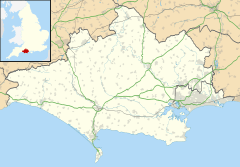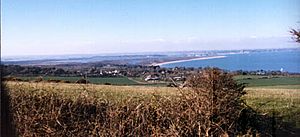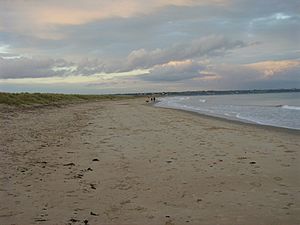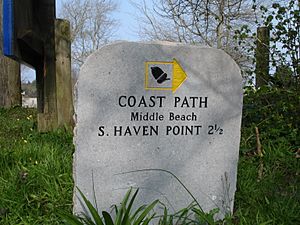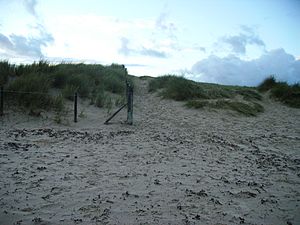Studland facts for kids
Quick facts for kids Studland |
|
|---|---|
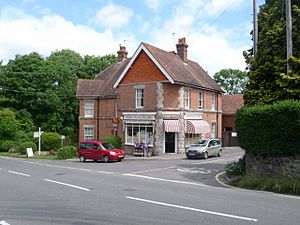 Studland village centre |
|
| Population | 425 (2011) |
| OS grid reference | SZ036825 |
| Civil parish |
|
| Unitary authority |
|
| Ceremonial county | |
| Region | |
| Country | England |
| Sovereign state | United Kingdom |
| Post town | SWANAGE |
| Postcode district | BH19 |
| Dialling code | 01929 |
| Police | Dorset |
| Fire | Dorset |
| Ambulance | South Western |
| EU Parliament | South West England |
| UK Parliament |
|
Studland is a lovely village and civil parish located on the Isle of Purbeck in Dorset, England. It's about 2 miles (3 km) north of Swanage and 3 miles (5 km) south of Sandbanks. The village is famous for its beautiful sandy beaches and a special nature reserve. In 2011, about 425 people lived here, but many houses are holiday homes, so the population changes with the seasons.
Contents
Discovering Studland Village
Studland is nestled behind Ballard Down, facing the calm Studland Bay. This bay has 2.5 miles (4 km) of sandy beaches, backed by sand dunes and heathland. The main beaches are called South Beach, Middle Beach, and Knoll Beach, plus another one at Shell Bay to the north.
Even though it's a coastal village, most houses in Studland are a bit inland. Long ago, a writer named Sir Frederick Treves described it as a quiet place with cottages hidden among trees and wild plants. He noticed that it didn't have a big harbour but turned away from the sea. However, he also saw that more tourists were arriving, and new buildings were changing the village.
Today, Studland has grown, with more homes built in the 20th century. One of the oldest buildings still standing is the village church, St Nicholas' Church. It looks much like it did when it was built around 1180, during Norman times. Near the church, there's a modern Celtic cross that was put up in 1976, using the base of an old Saxon cross.
Exploring Studland's Landscape
Studland Bay: Beaches and Coastal Care
Studland Bay is naturally protected from strong winds by Ballard Down and Handfast Point, a chalk headland. Over hundreds of years, sand has built up in the bay, creating the wide beaches and sand dunes you see today.
The beaches at Studland Bay are very popular, especially on sunny summer days, attracting thousands of visitors. This is because they are easy to reach from the nearby towns across Poole Harbour. The National Trust owns and looks after the beach and dunes north of the visitor centre. They limit parking to help prevent too many people from crowding the area.
In recent times, the amount of new sand coming into the bay has decreased, and the coastline is slowly eroding. This means that if nothing is done, the beach might shrink over time. The National Trust has discussed allowing natural processes to shape the coastline, even if it means some land might be lost.
The famous South West Coast Path ends at South Haven Point in Studland Bay, marked by a special sculpture.
Heathland and Nature's Wonders
Behind the sand dunes, there's a large area of heathland, called Studland Heath and Godlingston Heath. The National Trust also manages this area. Within Studland Heath, you'll find a freshwater lake called Little Sea. It was formed when the growing sand dunes cut it off from the sea. This lake is a safe home for many birds and other wildlife.
Studland and Godlingston Heath NNR has been a national nature reserve since 1946. It's considered one of the most important reserves in England. It's also a protected Site of Special Scientific Interest and part of the Dorset National Landscape. It's also a gateway to the amazing Jurassic Coast World Heritage Site.
On Godlingston Heath, there's a huge 17-foot (5 m) high rock called Agglestone Rock, which weighs about 400 tonnes. It's also known as the Devil's Anvil. Local legends say the devil threw it from the The Needles on the Isle of Wight, aiming for places like Corfe Castle. However, it's actually a natural rock formation that was left standing as the softer earth around it eroded away. In 1970, the rock fell onto its side, changing its unique anvil shape.
Oilfield
Hidden among a pine forest to the west of the heath is Perenco's Wytch Farm gathering station. This area is home to Britain's largest onshore oil field.
Studland's Past
Records from 1086 show that people in Studland made salt. St Nicholas' Church was built on the site of an even older Saxon building, which was destroyed by the Danes in the 9th century. Fishing was an important job in Studland in the 14th century.
In 1381, there was a castle on the cliffs at Handfast Point. By the 16th century, a new castle was built there, but it has since been lost to the sea due to coastal erosion. The Royal National Institution for the Preservation of Life from Shipwreck had a lifeboat at Studland from 1826 to 1848.
Studland in World War II
During World War II, in 1940, Studland Bay was seen as a likely spot for a German invasion, so it was heavily fortified. In 1942, the small village of Goathorn was evacuated, and the military took over the area. The village eventually disappeared into the heathland, but its pier remains.
The village and beach were used as a training ground for the D-Day landings in the Second World War. On Redend Point, a small sandstone cliff, you can see Fort Henry. This bunker was built in 1943 by Canadian engineers. It's 90 feet (27 m) long with 3-foot (1 m) thick walls and an 80-foot (24 m) wide observation slit.
In April 1944, seven Valentine tanks with special equipment sank in the bay during a training exercise called Exercise Smash, sadly leading to the death of six soldiers. On April 18, 1944, King George VI, General Sir Bernard Montgomery, and General Dwight D. Eisenhower met at the Knoll House Hotel in Studland to watch the training and discuss plans for the upcoming battle.
Amazing Wildlife of Studland
The Studland and Godlingston Heath National Nature Reserve is home to many different habitats, including heathland, bogs, woodlands, sand dunes, and freshwater areas. These support a wide variety of wildlife, including many birds and insects. In winter, Studland Bay is a great place to spot rare birds like black-necked grebes and great northern divers.
The Studland Peninsula is one of the best places in the UK to see Dartford warblers, with about 130 pairs nesting on the heath. This is about 7% of the entire UK population! The nature reserve is also one of the few places in Britain where you can find all six native reptile species.
Two types of seahorse (the spiny seahorse, Hippocampus guttulatus, and the short-snouted seahorse, Hippocampus hippocampus) have been found in Studland Bay. They live in a seagrass meadow at the southern end of the beach. People who live in Studland have reported seeing seahorses in the bay since at least the 1970s, possibly because the seagrass beds have grown.
The sand dunes here are held together by special salt-resistant grasses like couch grass and lyme-grass. These grasses help the dunes grow until longer-rooted marram grass can take over. As you move away from the shoreline, you'll find different types of dunes: "mobile dunes" that have been there for over 50 years, "semi-fixed" dunes with grasses and wildflowers, and "fixed dunes" that can even support bracken and small trees.
Near the Agglestone, you can find special bogs that have nutrient-poor, acidic soil. These bogs support unique plants like insect-eating sundews.
Famous People from Studland
- Charles Edmund Nugent, an Admiral of the Fleet
- Eyre Crowe, a British diplomat
- Herbert Cook, a Baronet
- Reginald Hoare, a British diplomat
- Stephen Warner, an evangelist


